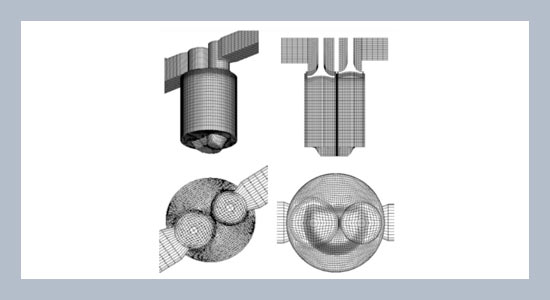REFERENCES
- Abani, N., Reitz, R. 2010. Diesel engine emissions and combustion predictions using advanced mixing models applicable to fuel sprays. Combustion Theory and Modelling, 14, 715–746.
- Amsden, A. 1993. KIVA-3: A KIVA program with blockstructured mesh for complex geometries. Report, Los Alamos National Laboratory, USA.
- Amsden, A. 1997. KIVA-3V: A block-structured kiva program for engines with vertical or canted valves. Report, Los Alamos National Laboratory, USA.
- Amsden, A. 1999. KIVA-3V, release 2, improvements to KIVA-3V. Report, Los Alamos National Laboratory, USA.
- Arroyo, J., Moreno, F., Muñoz, M., Monné, C., Bernal, N. 2014. Combustion behavior of a spark ignition engine fueled with synthetic gases derived from biogas. Fuel; 117, Part A, 50–58.
- Bestel, D, Bayliff, S, Marchese, A, Olsen, D, Windom, B, Xu, H. 2020. Multi-dimensional modeling of the CFR engine for the investigation of SI natural gas combustion and controlled End-gas autoignition. Proceedings of the ASME 2020 Internal Combustion Engine Division Fall Technical Conference. ASME 2020 Internal Combustion Engine Division Fall Technical Conference. Virtual, Online. V001T06A012. ASME. https://doi.org/10.1115/ICEF2020-2992
- Carrington, D., Waters, J., Weismiller, M. 2018. FEARCE development: A robust and accurate engine modeling software. FY2018 Annual progress report. Los Alamos National Laboratory. Available at shorturl.at/glswY Accessed: February 20 2020
- Chawner, J., Taylor, N. 2019. Progress in geometry modeling and mesh generation toward the CFD vision 2030. AIAA aviation forum. 1–13. https://doi.org/10.2514/6.2019-2945
- Chawner, J.R., Dannenhoffer, J., Taylor, N. 2016. Geometry, mesh generation, and the CFD 2030 vision. In 46th AIAA Fluid Dynamics Conference. 1–16. https://doi.org/10.2514/6.2016-3485
- Geuzaine, C., Remacle, J. 2009. Gmsh: a three-dimensional finite element mesh generator with built-in pre- and post-processing facilities. International Journal for Numerical Methods in Engineering 79, 1309–1331.
- Imamori, Y., Hiraoka, K., Murakami, S. et al. 2009. Effect of mesh structure in the KIVA-4 code with a less mesh dependent spray model for DI diesel engine simulations. SAE Int. J. Engines, 2, 1764–1776. https://doi.org/10.4271/2009-01-1937.
- Jafarmadar, S., Zehni, A. 2014. Numerical investigation of the effects of dwell time duration in a two-stage injection scheme on exergy terms in an IDI diesel engine by three-dimensional modeling. Energy Science & Engineering, 2, 1–13.
- Kim, H., Lee, S., Kim, H.J., Chun, J. 2020. Numerical study on the effects of tumble and swirl on combustion and emission characteristics of an LPG direct injection engine. International Journal of Automotive Technology. 21, 623–632.
- Kosmadakis, G.M., Rakopoulos, D.C., Rakopoulos, C.D. 2015. Investigation of nitric oxide emission mechanisms in a SI engine fueled with methane/hydrogen blends using a research CFD code. Int J of hydrogen energy; 40, 15088–15104.
- Lee, S., Park, S. 2010. Optimization of the piston bowl geometry and the operating conditions of a gasoline-diesel dual-fuel engine based on a compression ignition engine. Energy 121, 423–448.
- Nishad, K. 2018. Analysis of spray dynamics of urea-water-solution jets in a SCR-DeNOxsystem: An LES based study. International Journal of Heat and Fluid Flow 70, 247–258.
- Park, S. 2010. Optimization of combustion chamber geometry for stoichiometric diesel combustion using a micro genetic algorithm. Fuel Processing, 91, 17421752.
- Park, S., Shin, H. 2012. Efficient generation of adaptive Cartesian mesh for computational fluid dynamics using GPU. International journal for numerical methods in fluids. 70, 1393–404.
- Pérez Gordillo D. 2019. Estudio computacional de la combustión premezclada de un gas producto de la gasificación de biomasa en un motor de combustión interna (MCI). Tesis de Maestría en Ingenieria Mecánica, Universidad Nacional de Colombia, sede Bogotá.
- Rainsberger, R., Fong, J., Marcal, P. 2018. Application of an a priori Jacobian-Based Error Estimation Metric to the Accuracy Assessment of 3D Finite Element Simulations. Proceedings of the ASME 2018 Pressure Vessels and Piping Conference. Volume 6B: Materials and Fabrication. Prague, Czech Republic. V06BT06A076. ASME. https://doi.org/10.1115/PVP2018-84784.
- Sharma, C., Anand, T., Ravikrishna, R. 2010. A methodology for analysis of diesel engine in-cylinder flow and combustion. Progress in Computational Fluid Dynamics, 10, 157–167.
- Shi, Y., Liu, Y.F., Qiu, Z.H. 2016. Mesh generation of engine combustion chamber based on KIVA-3V. Mechanics and Mechanical Engineering, 446–450.
- Shimada, K. 2006. Current trends and issues in automatic mesh generation. Computer-Aided Design and Applications, 3, 741–750.
- Torres, D., Li, Y., Kong, S. 2009. Partitioning strategies for parallel KIVA-4 engine simulations. Computers and Fluids, 39, 301–309.
- Torres, D.J. 2007. KIVA-4 manual. Report, Los Alamos National Laboratory, USA.
- Torres, D.J., Trujillo, M.F. 2006. An unstructured ALE code for compressible gas flow with sprays. J of Computational Physics 219, 943–975.
- Weller, H., Tabor, G., Jasak, H., Fureby, C. 1998. A tensorial approach to computational continuum mechanics using object-oriented techniques. Computers in physics, 12, nov/dec.
- Wickman, D., Senecal, K., Reitz, R. 2001. Diesel engine combustion chamber geometry optimization using genetic algorithms, multi-dimensional spray, and combustion modeling. SAE paper 2001–01–0547.
- Wisconsin Engine Research Consultants (WERC). 2018. Mesh generation manual. Manual, Wisconsin Engine Research Consultants, USA.
- Xue, Q., Kong, S., Torres, D., Xu, Z. Yi, J. 2008. DISI Spray Modeling Using Local Mesh Refinement. SAE Technical Paper 2008-01-0967, https://doi.org/10.4271/2008-01-0967.
- Xue, Q., Song, C. 2009. Development of adaptive mesh refinement scheme for engine spray simulations. Computers & Fluids; 38, 939–949.
- XYZ Scientific Applications, Inc. 2002. TrueGrid. Software.
- Yi, J. 2008. Rapid mesh generation and dynamic mesh management for KIVA-3V. Report, Ford Research Laboratories, USA.
- Yu, S., Hai-Wen, G., Reitz, R. 2011. Computational optimization of internal combustion engines. 1st ed. Springer-Verlag London.
- Yuan, H., Yildiz, M., Merzari, E., Yu, Y., Obabko, A., Botha, G., Busco, G., Hassan, Y., Nguyen, D. 2020. Spectral element applications in complex nuclear reactor geometries: Tet-to-hex meshing. Nuclear Engineering and design, 357, 1–14.






